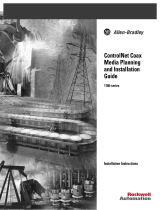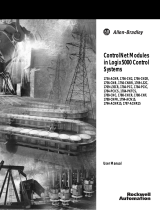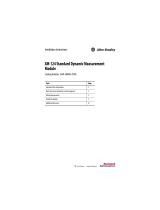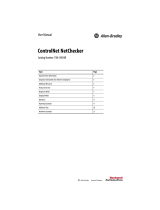Page is loading ...

Publication 1786-IN001B-EN-P - May 2004
Installation Instructions
ControlNet Dual Copper Repeater Module
Catalog Number 1786-RPCD
This document describes how to install and apply the 1786-RPCD dual copper repeater
module.
Topic: Page:
European Hazardous Location Approval 4
North American Hazardous Location Approval 6
About the Dual Copper Repeater Module 7
Mount the Repeater Module 9
Use Trunk Line Terminators 12
Remove the Repeater Module from the DIN Rail 13
Connect the Repeater Module 13
Understand Common Topologies 15
Understand Constraints of the Coax Segment 17
Status Indicators 19
Mounting Dimensions 20
Specifications 20
AB Parts

2 ControlNet Dual Copper Repeater Module
Publication 1786-IN001B-EN-P - May 2004
Important User Information
Solid state equipment has operational characteristics differing from those of electromechanical equipment.
Safety Guidelines for the Application, Installation and Maintenance of Solid State Controls (Publication
SGI-1.1 available from your local Rockwell Automation sales office or online at
http://www.ab.com/manuals/gi) describes some important differences between solid state equipment and
hard-wired electromechanical devices. Because of this difference, and also because of the wide variety of
uses for solid state equipment, all persons responsible for applying this equipment must satisfy themselves
that each intended application of this equipment is acceptable.
In no event will Rockwell Automation, Inc. be responsible or liable for indirect or consequential damages
resulting from the use or application of this equipment.
The examples and diagrams in this manual are included solely for illustrative purposes. Because of the many
variables and requirements associated with any particular installation, Rockwell Automation, Inc. cannot
assume responsibility or liability for actual use based on the examples and diagrams.
No patent liability is assumed by Rockwell Automation, Inc. with respect to use of information, circuits,
equipment, or software described in this manual.
Reproduction of the contents of this manual, in whole or in part, without written permission of Rockwell
Automation, Inc. is prohibited.
Throughout this manual we use notes to make you aware of safety considerations.
WARNING
Identifies information about practices or circumstances that can cause an explosion in a
hazardous environment, which may lead to personal injury or death, property damage,
or economic loss.
IMPORTANT
Identifies information that is critical for successful application and understanding of the
product.
ATTENTION
Identifies information about practices or circumstances that can lead to personal injury
or death, property damage, or economic loss. Attentions help you:
• identify a hazard
• avoid a hazard
• recognize the consequence
SHOCK HAZARD
Labels may be located on or inside the equipment to alert people that dangerous
voltage may be present.
BURN HAZARD
Labels may be located on or inside the equipment to alert people that surfaces may be
dangerous temperatures.

ControlNet Dual Copper Repeater Module 3
Publication 1786-IN001B-EN-P - May 2004
ControlNet is a trademark of ControlNet International, Inc.
ATTENTION
Environment and Enclosure
This equipment is intended for use in a Pollution Degree 2 industrial
environment, in overvoltage Category II applications (as defined in IEC
publication 60664-1), at altitudes up to 2000 meters without derating.
This equipment is considered Group 1, Class A industrial equipment
according to IEC/CISPR Publication 11. Without appropriate
precautions, there may be potential difficulties ensuring electromagnetic
compatibility in other environments due to conducted as well as radiated
disturbance.
This equipment is supplied as “open type” equipment. It must be
mounted within an enclosure that is suitably designed for those specific
environmental conditions that will be present and appropriately designed
to prevent personal injury resulting from accessibility to live parts. The
interior of the enclosure must be accessible only by the use of a tool.
Subsequent sections of this publication may contain additional
information regarding specific enclosure type ratings that are required to
comply with certain product safety certifications.
NOTE: See NEMA Standards publication 250 and IEC publication
60529, as applicable, for explanations of the degrees of protection
provided by different types of enclosure. Also, see the appropriate
sections in this publication, as well as the Allen-Bradley publication
1770-4.1 (“Industrial Automation Wiring and Grounding Guidelines”),
for additional installation requirements pertaining to this equipment.
AB Parts

4 ControlNet Dual Copper Repeater Module
Publication 1786-IN001B-EN-P - May 2004
European Hazardous Location Approval
If you install the module in a European Zone 2 location, consider:
ATTENTION
Preventing Electrostatic Discharge
This equipment is sensitive to electrostatic discharge, which can cause
internal damage and affect normal operation. Follow these guidelines
when you handle this equipment:
• Touch a grounded object to discharge potential static.
• Wear an approved grounding wriststrap.
• Do not touch connectors or pins on component boards.
• Do not touch circuit components inside the equipment.
• If available, use a static-safe workstation.
• When not in use, store the equipment in appropriate static-safe
packaging.
ATTENTION
This product is grounded through the DIN rail to chassis ground. Use
zinc plated yellow-chromate steel DIN rail to assure proper grounding.
The use of other DIN rail materials (e.g., aluminum, plastic, etc.) that can
corrode, oxidize, or are poor conductors, can result in improper or
intermittent grounding.
ATTENTION
European Zone 2 Certification (The following applies when the
product bears the EEx Marking)
This equipment is intended for use in potentially explosive atmospheres
as defined by European Union Directive 94/9/EC.
The LCIE (Laboratoire Central des Industries Electriques) certifies that
this equipment has been found to comply with the Essential Health and
Safety Requirements relating to the design and construction of Category 3
equipment intended for use in potentially explosive atmospheres, given in
Annex II to this Directive. The examination and test results are recorded
in confidential report No. 28 682 010.
Compliance with the Essential Health and Safety Requirements has been
assured by compliance with EN 50021.

ControlNet Dual Copper Repeater Module 5
Publication 1786-IN001B-EN-P - May 2004
IMPORTANT
This equipment is not resistant to sunlight or other sources of UV
radiation.
The secondary of a current transformer shall not be open-circuited when
applied in Class I, Zone 2 environments.
Equipment of lesser Enclosure Type Rating must be installed in an
enclosure providing at least IP54 protection when applied in Class I, Zone
2 environments.
This equipment shall be used within its specified ratings defined by
Allen-Bradley.
Provision shall be made to prevent the rated voltage from being exceeded
by transient disturbances of more than 40% when applied in Class I, Zone
2 environments.
AB Parts

6 ControlNet Dual Copper Repeater Module
Publication 1786-IN001B-EN-P - May 2004
North American Hazardous Location Approval
The following information applies when
operating this equipment in hazardous
locations:
Informations sur l’utilisation de cet équipement en
environnements dangereux:
Products marked “CL I, DIV 2, GP A, B, C, D” are
suitable for use in Class I Division 2 Groups A, B, C, D,
Hazardous Locations and nonhazardous locations only.
Each product is supplied with markings on the rating
nameplate indicating the hazardous location
temperature code. When combining products within a
system, the most adverse temperature code (lowest
“T” number) may be used to help determine the
overall temperature code of the system. Combinations
of equipment in your system are subject to
investigation by the local Authority Having
Jurisdiction at the time of installation.
Les produits marqués "CL I, DIV 2, GP A, B, C, D" ne
conviennent qu’à une utilisation en environnements de
Classe I Division 2 Groupes A, B, C, D dangereux et non
dangereux. Chaque produit est livré avec des marquages
sur sa plaque d’identification qui indiquent le code de
température pour les environnements dangereux.
Lorsque plusieurs produits sont combinés dans un
système, le code de température le plus défavorable
(code de température le plus faible) peut être utilisé pour
déterminer le code de température global du système.
Les combinaisons d’équipements dans le système sont
sujettes à inspection par les autorités locales qualifiées
au moment de l’installation.
WARNING
EXPLOSION HAZARD
• Do not disconnect equipment
unless power has been
removed or the area is known
to be nonhazardous.
• Do not disconnect
connections to this
equipment unless power has
been removed or the area is
known to be nonhazardous.
Secure any external
connections that mate to this
equipment by using screws,
sliding latches, threaded
connectors, or other means
provided with this product.
• Substitution of components
may impair suitability for
Class I, Division 2.
• If this product contains
batteries, they must be
changed only in an area
known to be nonhazardous.
AVERTISSEMENT
RISQUE D’EXPLOSION
• Couper le courant ou
s’assurer que
l’environnement est
classé non dangereux
avant de débrancher
l'équipement.
• Couper le courant ou
s'assurer que
l’environnement est
classé non dangereux
avant de débrancher les
connecteurs. Fixer tous
les connecteurs externes
reliés à cet équipement à
l'aide de vis, loquets
coulissants, connecteurs
filetés ou autres moyens
fournis avec ce produit.
• La substitution de
composants peut rendre
cet équipement inadapté
à une utilisation en
environnement de Classe
I, Division 2.
• S’assurer que
l’environnement est
classé non dangereux
avant de changer les
piles.

ControlNet Dual Copper Repeater Module 7
Publication 1786-IN001B-EN-P - May 2004
About the Dual Copper Repeater Module
Use this copper repeater module when the:
• design of the network requires a hub-based topology
• segment requires a greater copper distance
• design requires an isolated segment
• number of nodes requires the use of repeaters (refer to Understand Constraints of the
Coax Segment on page 1-17)
The copper repeater module allows multiple 1000m copper segments to be attached to a
repeater adapter (1786-RPA). See pages15-18 for topology examples and segment length
constraints.
The module provides two copper channels and activity status indicators for each channel.
WARNING
If you insert or remove the module while backplane power is
on, an electrical arc can occur. This could cause an explosion
in hazardous location installations.If you insert or remove the
module while backplane power is on, an electrical arc can oc
-
cur. This could cause an explosion in hazardous location instal-
lations.
Be sure that power is removed or the area is nonhazardous be-
fore proceeding.
WARNING
If you connect or disconnect the communications cable with
power applied to this module or any device on the network, an
electrical arc can occur. This could cause an explosion in haz
-
ardous location installations.
AB Parts

8 ControlNet Dual Copper Repeater Module
Publication 1786-IN001B-EN-P - May 2004
The figure below identifies the components of the module:
Indicators
Channel 1
coax port
Channel 2
coax port
Module
locking tab
Right-side backplane
connector with
protective cover
42210
The left side of the
module (not shown
here) also contains a
backplane connector.
75 Ω BNC Trunk line terminators
(1786-XT)
Important:You must terminate
unused channels to maintain the
integrity of your network.

ControlNet Dual Copper Repeater Module 9
Publication 1786-IN001B-EN-P - May 2004
Mount the Repeater Module
To mount the module on the DIN rail:
1. Position the module on the 35×7.5mm DIN rail (Allen-Bradley part number
199-DRI; 46277-3; EN 50022) at a 30° angle.
2. Hook the module lip (on the rear of the module) onto the top of the DIN rail and
rotate the module onto the rail.
3. Press the module down to the DIN rail until the module is flush with the rail.
The locking tab should snap into position and lock the module onto the DIN rail. If
the tab does not snap into position, follow step 4. If the tab does snap into position,
go to step 5.
ATTENTION
This product is grounded through the DIN rail to chassis ground.
Use zinc plated yellow-chromate steel DIN rail to assure proper
grounding. The use of other DIN rail materials (e.g., aluminum,
plastic, etc.) that can corrode, oxidize, or are poor conductors, can
result in improper or intermittent grounding.
IMPORTANT
To ensure proper operation of the 1786-RPCD repeater module, you
must position the 1786-RPCD module to the left of any 1786-RPFRL or
1786-RPFRXL repeater modules in your configuration.
30074-M
AB Parts

10 ControlNet Dual Copper Repeater Module
Publication 1786-IN001B-EN-P - May 2004
4. Use a screwdriver to move the locking tab down while you press the module flush
onto the DIN rail. Release the locking tab to secure the module in place. If necessary,
push up on the locking tab to secure the module in place.
30076-M
30074-M

ControlNet Dual Copper Repeater Module 11
Publication 1786-IN001B-EN-P - May 2004
5. Once you attach the modules to the DIN rail, slide the modules to the left to attach to
the repeater adapter or another repeater module.
6. Use DIN rail end anchors to secure the units together.
7. Connect terminators to unused channels as shown in Use Trunk Line Terminators on
page 12.
IMPORTANT
Because the 1786-RPCD repeater module is part of the modular family of
ControlNet repeaters, you must use the 1786-RPA repeater adapter to
supply power and coordinate the modules’ TX and RX function.
To ensure proper operation of the 1786-RPCD repeater module, you
must position the 1786-RPCD module to the left of any 1786-RPFRL or
1786-RPFRXL repeater modules in your configuration.
IMPORTANT
You can attach a maximum of four repeater modules (1786-RPCD) to a
repeater adapter (1786-RPA). If you exceed the repeater limit, you may
cause damage to the repeater adapter and repeaters. Four repeaters can
draw up to 1.6A @ 5V dc in power consumption. If you exceed this
power limit, you may cause damage to the repeater adapter and repeaters.
ATTENTION
Be certain that you secure the adapter and repeater modules together with
DIN rail end anchors. Failure to do so may result in loss of communication
and/or damage to modules.
31493-M
You must use a DIN rail end anchor on the
right side of the copper module if it is the
right-most module.
AB Parts

12 ControlNet Dual Copper Repeater Module
Publication 1786-IN001B-EN-P - May 2004
8. Connect the module wiring as shown in Connect the Module For Coax Channels 1
and 2 on page 14.
9. Ground your DIN rail in accordance with local codes using a minimum #14 AWG
wire. See page
12 for DIN rail ground wire example.
Use Trunk Line Terminators
When you are not connecting a trunk line to a channel on the 1786-RPCD repeater module,
connect a 75
Ω terminating resistor (1786-XT) to maintain the integrity of your network.
If: Then:
you are not going to use a channel keep the terminator on an unused channel for optimal
network performance
you connect another repeater module or repeater
adapter to the right backplane connector
remove the protective backplane cap and save the
cap for future use
you are not going to connect a module to the right
backplane connector
leave the backplane cap attached
the module is in the right-most position attach a DIN rail end anchor
31494-M
DIN rail
Terminator
Protective
backplane cap
The left side of the module
(not shown here) also
contains a backplane
connector.
Be certain to ground the DIN rail
with a minimum #14 AWG wire.

ControlNet Dual Copper Repeater Module 13
Publication 1786-IN001B-EN-P - May 2004
Remove the Repeater Module from the DIN Rail
To remove the module from the DIN rail, do the following:
1. Insert a screwdriver into the module locking tab.
2. Gently pry up on the locking tab.
The module should detach from the DIN rail. If the module does not unlock, try
more pressure while you pry up on the locking tab with the screwdriver.
Connect the Repeater Module
TIP
If you need to connect only one coax channel on the 1786-RPCD module,
you can use either channel 1 or channel 2. Both channels 1 and 2 operate
identically and can be used interchangeably.
Be sure to terminate the unused channel with a 75-Ω terminating resistor
(1786-XT).
31491-M
AB Parts

14 ControlNet Dual Copper Repeater Module
Publication 1786-IN001B-EN-P - May 2004
Connect the Module For Coax Channels 1 and 2
1. Connect the ControlNet tap to port #1.
a. Align the knob of the BNC cable connector with the locks of the BNC module
connector, and insert the connector into channel 1.
b. Twist the BNC connector until the bayonet lug is locked into place.
2. To connect channel 2, repeat Step 1 for channel 2. If channel 2 is not used, connect a
75-
Ω terminating resistor (1786-XT) to the port labeled channel 2.
3.
For examples of properly connected channels,
refer to the example topologies on pages 15
through 17.
31492-M
75 Ω
terminator
Tap
BNC connector

ControlNet Dual Copper Repeater Module 15
Publication 1786-IN001B-EN-P - May 2004
Understand Common Topologies
The following topologies show how you can use the module.
Series Topology
The following figure shows the 1786-RPCD wired in series. This topology can be used to
extend the trunk line.
1794-ACNR15
1786-RPCD
1786-RPCD
PLC
REPEATER DUAL COPPER MODULE
1786-RPCD
REPEATER DUAL COPPER MODULE
1786-RPCD
CH 1 CH 2
CH 1 CH 2
1786-RPA 1786-RPA
1794-ACNR15
31484-M
Connect 1786-RPA repeater adapter to a 24V dc
Class 2 power supply.
AB Parts

16 ControlNet Dual Copper Repeater Module
Publication 1786-IN001B-EN-P - May 2004
Star Topology
The following figure shows a star configuration that supports 16 usable segments. The two
1786-RPA repeater adapters create a central hub with the 1786-RPCD modules forming 16
segments
.
1786-RPCD
REPEATER DUAL COPPER MODULE
1786-RPCD
1786-RPCD
to
Segment 8
Segment 1
Segment 9
Segment 16
REPEATER DUAL COPPER MODULE
1786-RPCD
1786-RPCD
REPEATER DUAL COPPER MODULE
1786-RPCD
1786-RPA
1786-RPCD
REPEATER DUAL COPPER MODULE
1786-RPCD
1786-RPA
1786-RPCD
REPEATER DUAL COPPER MODULE
1786-RPCD
1786-RPCD
REPEATER DUAL COPPER MODULE
1786-RPCD
1786-RPCD
REPEATER DUAL COPPER MODULE
1786-RPCD
1786-RPCD
REPEATER DUAL COPPER MODULE
1786-RPCD
16 segments, 2 1786-RPA repeater adapters in series
with a maximum of 4 1786-RPCD modules per repeater adapter.
31485-M

ControlNet Dual Copper Repeater Module 17
Publication 1786-IN001B-EN-P - May 2004
Redundant Topology
Use redundant media when you need module and media redundancy. With redundant media,
the channel-to-channel skew travel time difference must be less than 1.6
µs.
For more information on redundant topology, refer to the ControlNet Fiber Media Planning
and Installation Guide, publication CNET-IN001.
Understand Constraints of the Coax Segment
The total allowable length of a segment containing standard RG-6 quad shield coaxial cable
depends upon the number of taps in your segment. There is no minimum trunk-cable section
length requirement.
The maximum allowable total length of a segment is 1,000m (3,280ft) with two taps
connected. Each additional tap decreases the maximum length of the segment by 16.3m
(53ft). The maximum number of taps allowed on a segment is 48 with a maximum length of
250m (820ft).
TIP
Redundant media can be used with series and star topologies. You
cannot use redundant media with ring redundant topology.
31497-M
1786-RPA 1786-RPA
CH B
CH A
CH B
CH A
1794-ACNR15
1786-RPA 1786-RPA
CH1
CH2
1786-RPCD
1786-RPA
CH1
CH2
1786-RPCD
1786-RPA
CH1
CH2
1786-RPCD
CH1
CH2
1786-RPCD
CH1
CH2
1786-RPCD
CH1
CH2
1786-RPCD
AB Parts

18 ControlNet Dual Copper Repeater Module
Publication 1786-IN001B-EN-P - May 2004
Figure 1 Maximum segment length (assumes you are using 1786-RG6 coax
cable)
For more information in the installation of a coax segment, see publication CNET-IN002,
ControlNet Coax Media Planning and Installation Guide.
EXAMPLE
If your segment requires 10 taps, the maximum segment length is:
1000m (3280ft) - 16.3m (53.4ft) x [10 - 2]
1000m (3280ft) - 130.4m (427.7ft) = 869.6m (2852.8ft)
The total trunk-cable length or number of taps can be increased by
installing repeaters on the segment. This creates another segment.
The amount of high-flex RG-6 cable (1786-RG6F) you can use in a
system is less than the amount of standard RG-6 cable, so you should
keep high-flex cable use to a minimum. Use BNC bullet connectors to
isolate areas that require high-flex RG-6 cable from areas that require
standard RG-6 cable; this allows the high-flex RG-6 section to be
replaced before flexture life is exceeded.
1000 (3280)
750 (2460)
500 (1640)
250 (820)
2
16
32
48
maximum allowable segment length = 1000m (3280ft) - 16.3m (53.4ft) X [number of taps - 2]
number of taps
s
e
g
m
e
n
t
l
e
n
g
t
h
m
30014-M

ControlNet Dual Copper Repeater Module 19
Publication 1786-IN001B-EN-P - May 2004
Status Indicators
The figure below identifies indicators on the module:
The table below defines Channel 1 and Channel 2 status indicators.
Status Indicator: Probable Cause:
Off No power or module faulted
Green Channel operational
Flashing Green/Off No data activity on associated channel
Channel 1 status
Channel 2 status
31489-M
AB Parts

20 ControlNet Dual Copper Repeater Module
Publication 1786-IN001B-EN-P - May 2004
Mounting Dimensions
The figure below shows the dimensions for mounting the module.
Specifications
Specification Value
Operational Temperature IEC 60068-2-1 (Test Ad, Operating Cold),
IEC 60068-2-2 (Test Bd, Operating Dry Heat),
IEC 60068-2-14 (Test Nb, Operating Thermal Shock):
0 to 60 °C (32 to 140 °F)
Storage Temperature IEC 60068-2-1 (Test Ab, Un-packaged Non-operating Cold),
IEC 60068-2-2 (Test Bb, Un-packaged Non-operating Dry Heat),
IEC 60068-2-14 (Test Na, Un-packaged Non-operating Thermal Shock):
-40 to 85 °C (-40 to 185 °F)
Relative Humidity IEC 60068-2-30 (Test Db, Un-packaged Non-operating Damp Heat):
5 to 95% non-condensing
Vibration IEC 60068-2-6 (Test Fc, Operating):
5g@10 - 500Hz
Operating Shock IEC 60068-2-27 (Test Ea, Unpackaged Shock):
30g
Non-operating Shock IEC 60068-2-27 (Test Ea, Unpackaged Shock):
50g
4.44in
(111mm)
3.6in
(90mm)
4.048in
(101.2mm)
2.76in
(69mm)
4.0in
(100mm)
31495-M
/





